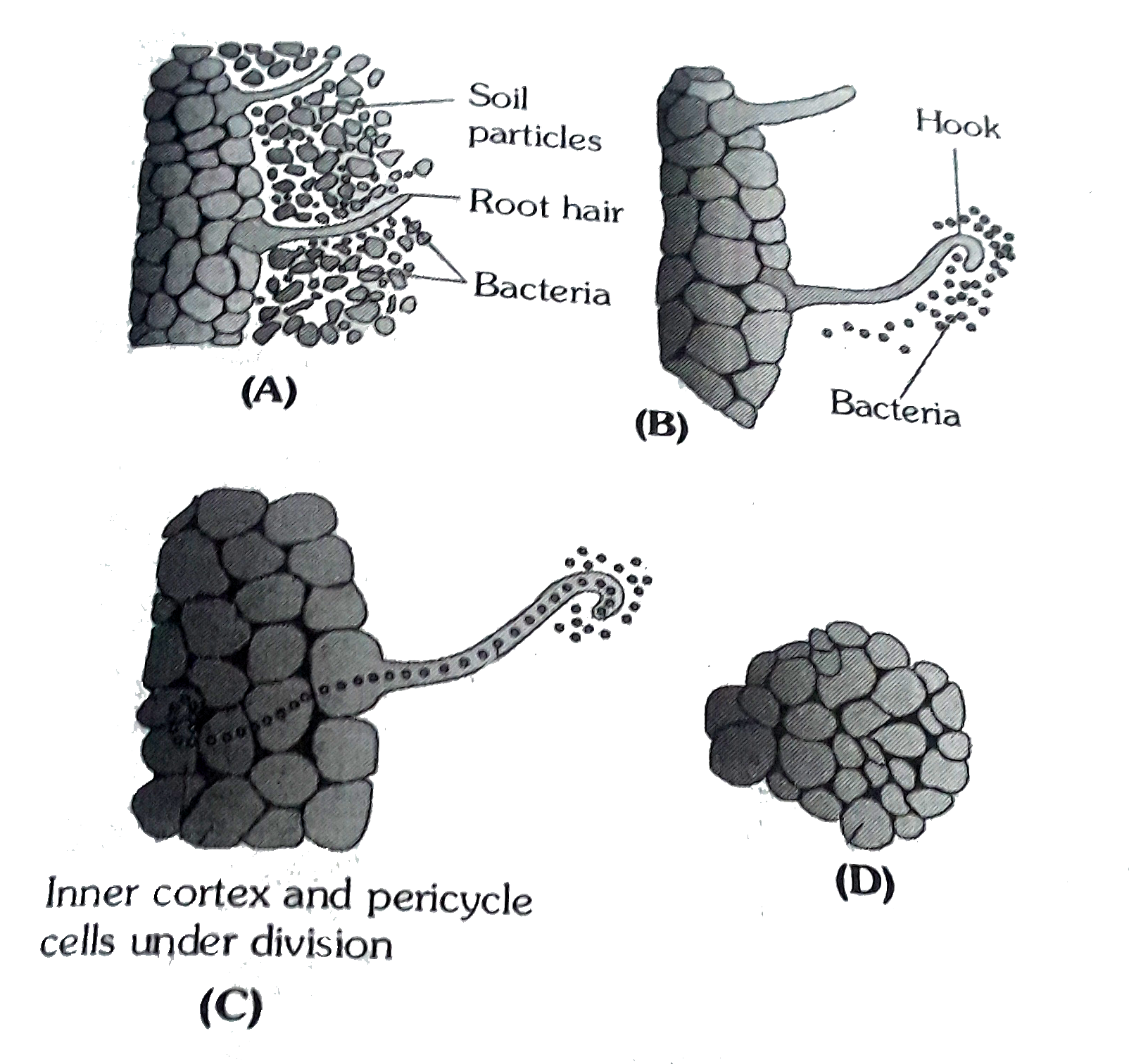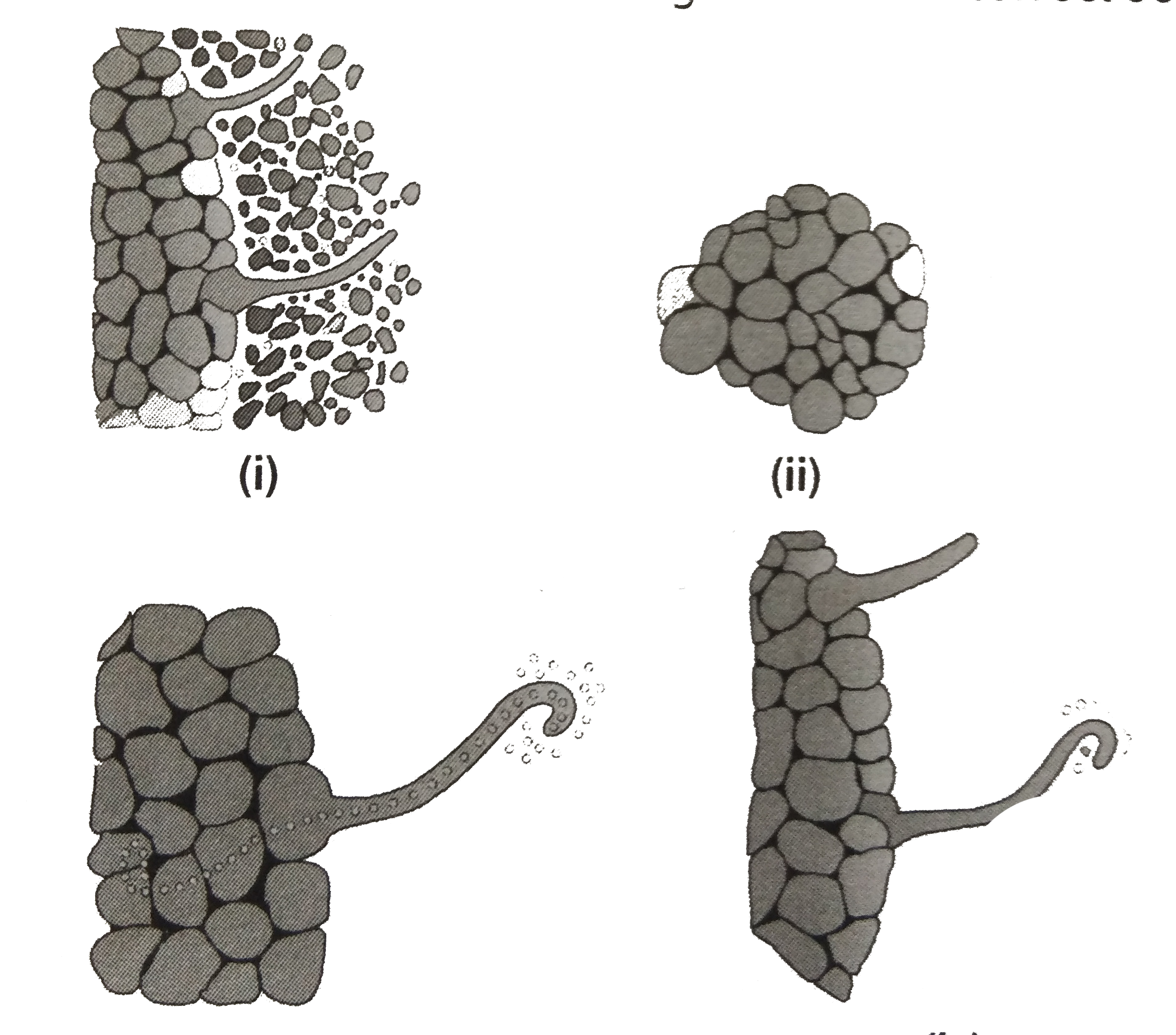Study the given figure which shows the development of root nodules in soyabean. Match the correct explanation and find the correct sequence for labelled diagrams.

(I) Rhizobium bacteria contacting a susceptible root hair.
(II) A mature nodule having vascular connection with roots.
(III). Infection thread carrying bacteria to the inner cortex.
(IV). Curling of root hair due to successful infection.
The correct Answer is:A−I→B−IV→C−III→D−II
Step by step video & image solution for Study the given figure which shows the development of root nodules in soyabean. Match the correct explanation and find the correct sequence for labelled diagrams. (I) Rhizobium bacteria contacting a susceptible root hair. (II) A mature nodule having vascular connection with roots. (III). Infection thread carrying bacteria to the inner cortex. (IV). Curling of root hair due to successful infection. by Biology experts to help you in doubts & scoring excellent marks in Class 12 exams.
Updated on:21/07/2023Similar Questions

Study the given figures carefully showing the development of root nodules and arrange them in a correct sequence.
View SolutionDuring nodule formation in leguminous plants, an infection thread is produced carrying the (i) into the (ii) of the root, where they initiate the nodule formation in the (iii) of the root. Fill up the blanks by choosing the correct option.
View Solution
Knowledge Check
The different steps in a nodule formation are given below
I. A matured nodule establishes a direct vascular connection
II. Root hair curls and the bacteria invade the root hair with the host for exchange of nutrients
III. Rhizobium bacteria contact a susceptile root hair, divide near it
IV. The infection thread is produced carring the bacteria and grows into the cortex of the root
V. The bacteria get modified into rod-shaped bacteroids and cause inner cortical layer and pericycle to divide to form nodule.
The correct sequence is -AIII, II, IV, I, V.BIII, II, IV, V, ICIV, V, III, II, IDI, III, V, II, IVChoose the correct sequence of step w.r.t nodule formation in legumes.
(a) Root nodule formation
(b) Infection thread formation
(c ) Curling of root hair
(d) Division of cortical cellsAc,d,b,aBc,b,d,aCc,b,a,dDb,c,a,dSequential stage for nodule formation are
I. Rhizobia multiply and colonize the surrounding roots.
II. Rhizobia get attached to epidermal and root hair cells.
III. Root hair curl and bacteria invade root hair.
IV. Initiation of nodule formation in cortex.
V. Infection thread is produced carrying bacteria to cortex.
VI. Bacteria released from thread into cells and cause their differentiation in specialized nitrogen fixing cells.
VII. Nodule formed establishes a direct vascular connection with the host for exchange of nutrient.AI→VII→II→VI→II→V→IVBII→III→IV→I→VII→V→VICVII→VI→IV→I→III→V→IIDI→II→III→V→IV→VI→VII
Four statements regarding root hairs are given below. Choose the correct one from them
I) They are unbranched tubular extensions
II) They are fine, delicate thread like structures
III) They are present on tap root and absent in all adventitious roots
IV) They are uniformly distributed in all regions of root
View SolutionConsider the following steps involved in nodule formation in the root of a legume.
(i). Bacteria release chemicals and enzymes.
(ii). Bacteria stop dividing and form bacteroides.
(iii). Roots secrete chemical atractants.
(iv). Formation of infection thread.
(v). Formation of nodules.
(v). Formation of nodulues.
(vi). Division of infected cortical cells.
(vii) Curlinig of root hair and degradation of their cell wall.
(viii). Infection thread grows along with multiplication of bacteria.
Arrange the steps in the right sequence and mark the correct option
View SolutionGo through the following matches with reference to the elements and their deficiency symptoms in plants:
(i) Sulphur - Reduced nodulation in legumes
(ii) Boron - Whiptail disease
(iii) Sulphur - Blossom end root of tomato
(iv) Nitrogen - Wrinkling of cereal grains
Which of these are correct
View SolutionGo through the following matches with reference to the elements and their deficiency symptoms in plants:
(i) Sulphur - Reduced nodulation in legumes
(ii) Boron - Whiptail disease
(iii) Sulphur - Blossom end root of tomato
(iv) Nitrogen - Wrinkling of cereal grains
Which of these are correct
View SolutionGo through the following statements
(i) The most widely used compound as source of ethylene is ethephon.
(ii) Ethylene helps the plants to increa their absorption surface by promotin root growth and root hair formation.
(iii) 2, 4 - D is mainly used to kill mature monocotyledonous plants.
(iv) Spraying juvenile conifers with GAs has- tens the maturity period, thus leading to early seed production.
Which of these are correct
View Solution
